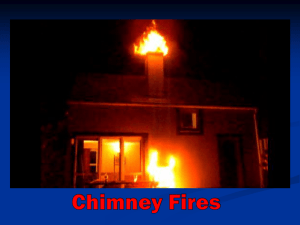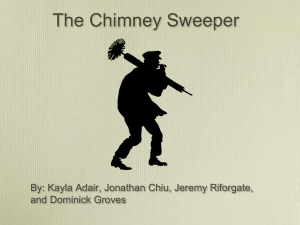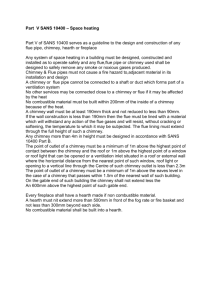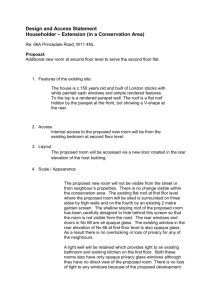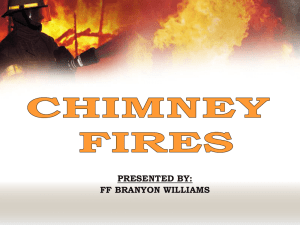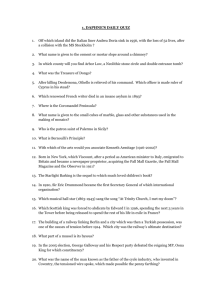Delegated report 320120887 - Ribble Valley Borough Council
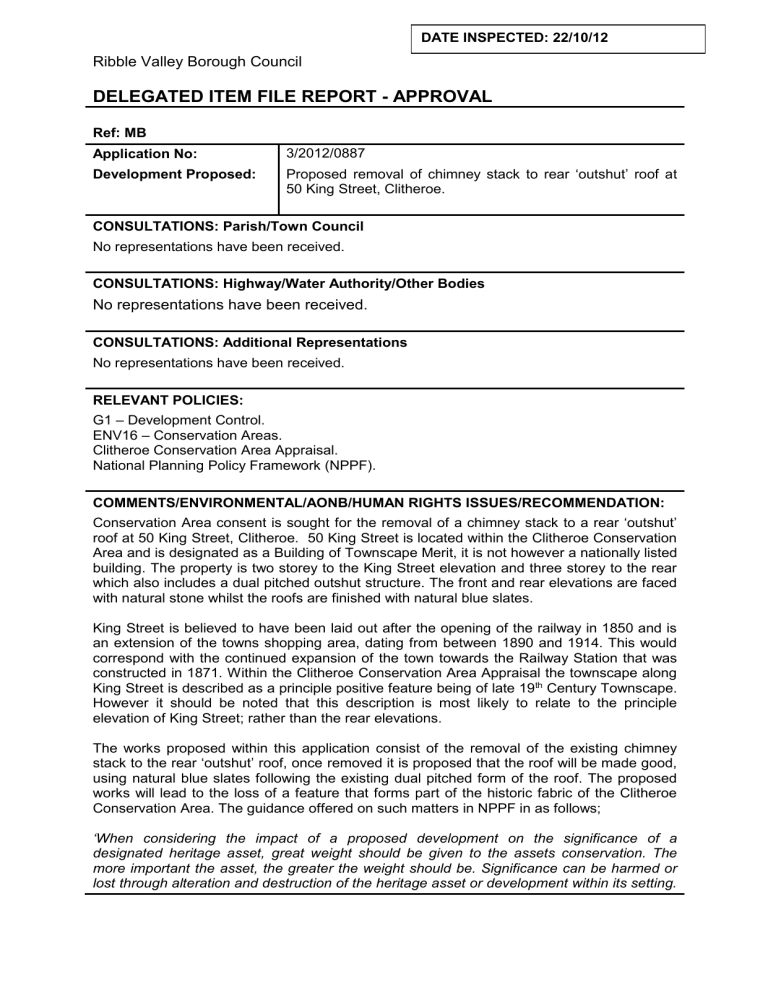
DATE INSPECTED: 22/10/12
Ribble Valley Borough Council
DELEGATED ITEM FILE REPORT - APPROVAL
Ref: MB
Application No: 3/2012/0887
Development Proposed: Proposed removal of chimney stack to rear ‘outshut’ roof at
50 King Street, Clitheroe.
CONSULTATIONS: Parish/Town Council
No representations have been received.
CONSULTATIONS: Highway/Water Authority/Other Bodies
No representations have been received.
CONSULTATIONS: Additional Representations
No representations have been received.
RELEVANT POLICIES:
G1 – Development Control.
ENV16 – Conservation Areas.
Clitheroe Conservation Area Appraisal.
National Planning Policy Framework (NPPF).
COMMENTS/ENVIRONMENTAL/AONB/HUMAN RIGHTS ISSUES/RECOMMENDATION:
Con servation Area consent is sought for the removal of a chimney stack to a rear ‘outshut’ roof at 50 King Street, Clitheroe. 50 King Street is located within the Clitheroe Conservation
Area and is designated as a Building of Townscape Merit, it is not however a nationally listed building. The property is two storey to the King Street elevation and three storey to the rear which also includes a dual pitched outshut structure. The front and rear elevations are faced with natural stone whilst the roofs are finished with natural blue slates.
King Street is believed to have been laid out after the opening of the railway in 1850 and is an extension of the towns shopping area, dating from between 1890 and 1914. This would correspond with the continued expansion of the town towards the Railway Station that was constructed in 1871. Within the Clitheroe Conservation Area Appraisal the townscape along
King Street is described as a principle positive feature being of late 19 th Century Townscape.
However it should be noted that this description is most likely to relate to the principle elevation of King Street; rather than the rear elevations.
The works proposed within this application consist of the removal of the existing chimney stack to the rear ‘outshut’ roof, once removed it is proposed that the roof will be made good, using natural blue slates following the existing dual pitched form of the roof. The proposed works will lead to the loss of a feature that forms part of the historic fabric of the Clitheroe
Conservation Area. The guidance offered on such matters in NPPF in as follows;
‘When considering the impact of a proposed development on the significance of a designated heritage asset, great weight should be given to the assets conservation. The more important the asset, the greater the weight should be. Significance can be harmed or lost through alteration and destruction of the heritage asset or development within its setting.
As heritage assets are irreplaceable, any harm or loss should require clear and convincing justification.’ (para 132, NPPF).
Therefore the main consideration in the determination of this application is to consider the harm that would be caused by allowing the chimney stack to be demolished and whether this loss of historic fabric would be sufficient to warrant the refusal of consent. Both NPPF and
Policy ENV16 of the Distrcitwide Local Plan place great weight on assessing the harm that development or works could have upon the character and setting of the historic environment.
Any works or development that would detrimentally harm such amenities will be deemed to be unacceptable.
The Conservation Area appraisal and associated guidance notes make various references to the importance of features such as chimney stacks. The Conservation Area Guidance Notes go on to state; ‘ Chimney Stacks are both formal and functional features of the roofscape. In many cases chimneys also perform a vital structural function, and they should normally be retained, even when no longer required. If the stacks become unsafe, they should be taken down and rebuilt to the original height and design. Chimney pots can sometimes be valuable decorative features in their own right, but they are also functional features. A traditional roofscape can be damaged by their removal.’
Therefore in assessing this application; the contribution the chimney makes to the
Conservation Area has to be considered against the harm that would be caused should it be lost.
The current chimney is located to a rear outshut roof, as such it does not form part of the principle elevation of the building. Due to its scale and location it does not make any contribution to the townscape of King Street. The chimney can however be viewed from public vantage points. Principally this view is from the back street/footway that exists to the rear of the property; this runs East to West from Railway View Avenue to Railway View
Road. A well used highway that is present on the 1806 OS Map and currently provides one of the main pedestrian routes into the town centre from the train station.
From the vantage point of the back street/footway that exists to the rear of the property the three properties that make up the terrace, and there ‘outshut’ extension type structures can be viewed collectively. Of three the central property (No.52) has what could be considered to be a chimney in its original state, insofar as it appears to be complete. The property to the right of this (No.54/ Dawson’s) has no chimney whilst the property which is the subject of this application has a shorter stub chimney. It is not believed that the chimney in its current form is an original feature; this is in part due to the condition of the chimney on the neighbouring property. I am of the opinion that the current chimney could be considered to be in a semidemolished state or certainly in a state of disrepair.
As part of the submission the applicant has provided a detailed heritage statement that discusses the contribution the chimney makes to the building and the Conservation Area and also the impact that may be caused by the works proposed. Having considered this I agree with the comments made in the submitted heritage statement; that in its current form the chimney makes a negative or at best a neutral contribution to the character and setting of the Conservation Area.
I am therefore of the opinion that in allowing the chimney to be removed the character and setting of the Conservation Area will not be detrimentally harmed. This is because, as discussed above the chimney makes no contribution to the significance of the principle elevation of the property, nor particularly the wider Conservation Area. Whilst the rear elevation is readily visible due to the well-established and well used highway to the rear I am of the opinion that the chimney does not form a principle feature of the rear elevation. This is because of its current state of repair but also by virtue of the fact that there is another
chimney on the rear roof elevation on the main body of the dwelling.
In addition to these factors the neighbouring property of 54 King Street, (now part of
Dawson’s) has previously had a similar chimney removed and I do not believe that this has been to the detriment of the Conservation Area. I am therefore confident that should these works be undertaken and finished to a high standard at No.50, that no undue harm will be caused to the Conservation Area.
It should also be noted that there are instances, particularly with buildings of this nature, that certain works such a demolition can provide long term benefits and safeguards to the building. Detailed within the submission the applicant has stated that the current chimney presents maintenance issues. If the chimney is removed these ongoing maintenance issues are addressed. This could then help to preserve the wider character and setting of the building. The reinstatement of the dual pitched slate roof may also positively contribute to the character of the Conservation Area and help ensure its long term protection.
Due to the nature of the works proposed and the age of the building a Bat Survey has been submitted as part of the application. The survey has found no evidence of any bat activity on the site and that any harm to a protected species would be low. However notwithstanding this Bats are a species that are protected by law; and due to their nature no bat survey can be 100% conclusive. I will therefore recommend the use of a standard condition in relation to their ongoing protection during the works.
Having considered all of the submitted details I am of the opinion that the proposed works would not be detrimental to the character and setting of the Conservation Area; and that on balance the potential benefits the removal will have outweigh any harm that would be caused. I therefore see no objections to the granting of this consent and I recommend accordingly.
SUMMARY OF REASONS FOR APPROVAL:
The proposal has no significant visual impact on the building or adverse affect upon the setting of the Conservation Area.
RECOMMENDATION : That conditional planning consent is granted.
